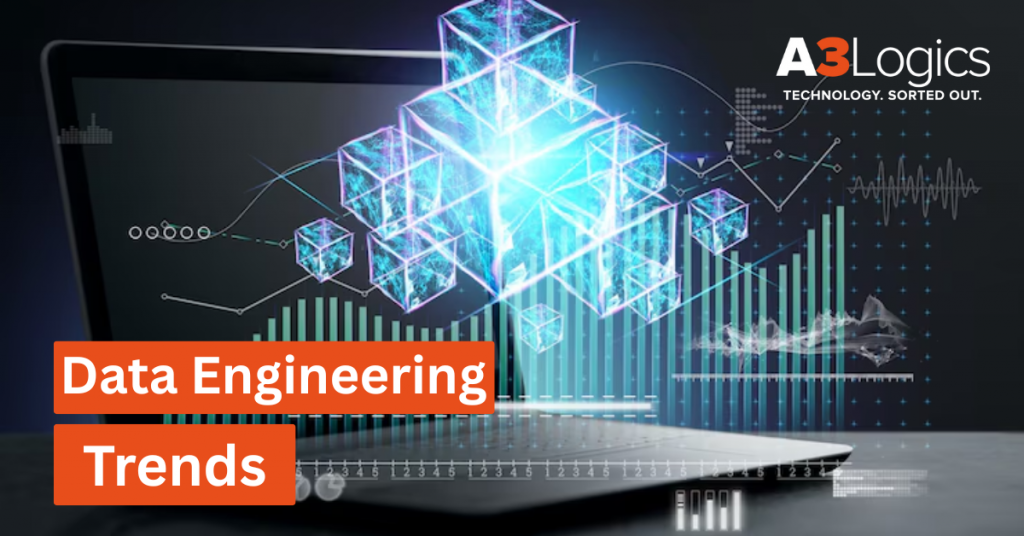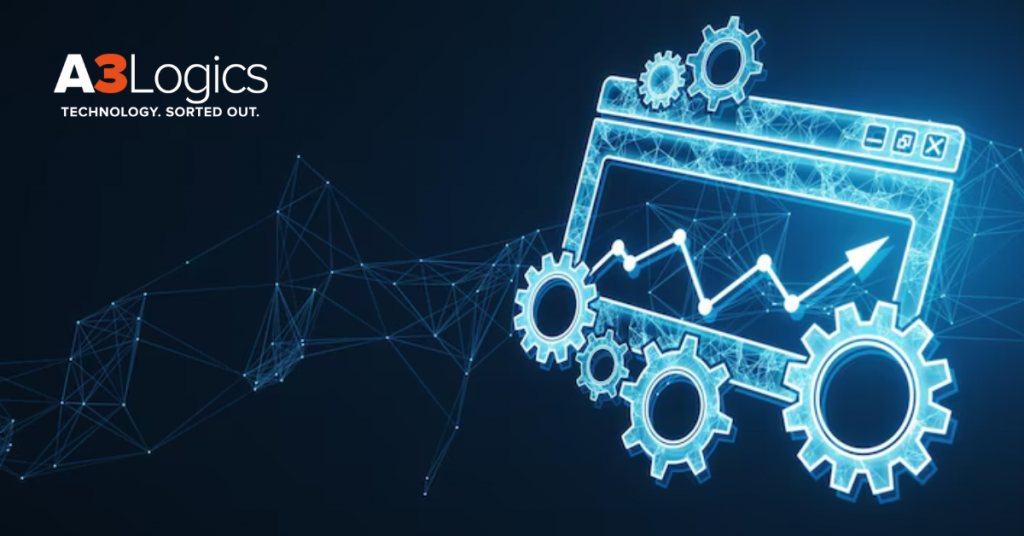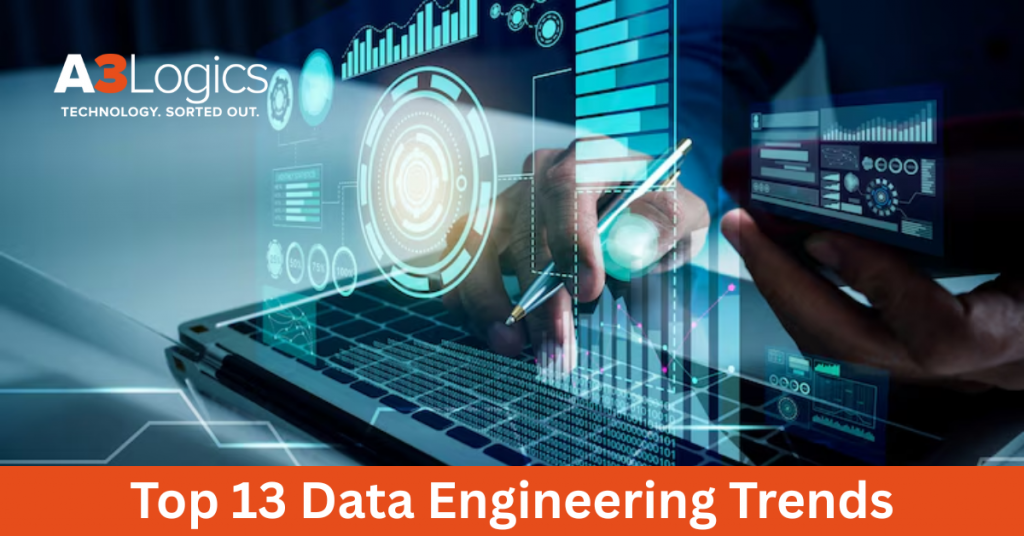Data Engineering Trends: With each click, swipe, and transaction, an ocean of data is created. This data presents both an opportunity and a challenge for organizations today. While the sheer volume of data provides opportunities for useful insights, it also presents challenges such as integration complexity, varying quality, and the need for real-time processing.

The current data engineering methodologies are straining – to keep up with rising demand. Data silos, inconsistent formats, and the impending prospect of security breaches all complicate the data landscape. This has spawned a demand for better, more effective solutions.
We know that data is the lifeblood of every enterprise. Data engineering is the backbone that supports – efficient, reliable, and scalable data systems. As we head into 2025; the emerging data engineering technologies are skyrocketing. Companies are striving to become more data-driven, and to do so, they need to adopt the latest data engineering trends, technologies and practices.
So, in this article, we’ll look at the newest data engineering trends affecting data in 2025 and how they’re allowing businesses to achieve the full potential of their data.
Table of Contents
The Growing Importance of Data Engineering in 2025
Businesses use data to make decisions, forecast trends, and provide personalized client experiences. However, as data rises in size, speed, and complexity, efficient management becomes more difficult. These shifts are requiring everyone to reconsider how they manage data pipelines and strategies.

One big difference is the massive volume of data being produced. From IoT devices and social media platforms to corporate systems, businesses are inundated with structured and unstructured data. Traditional data processing and analysis methods are simply not up to the task, resulting in delays and bottlenecks. To remain competitive, businesses are looking for more flexible, scalable, and cost-effective solutions, such as data platform modernization and cloud-native designs.
Another concern is the growing complexity of data systems. Today, data comes from a variety of sources, each with its own set of formats and standards, making integration and administration difficult. This results in difficulties like data silos, variable quality, and delays in obtaining meaningful insights. When you add in the increased demand for real-time analytics, enhanced security, and rigorous regulatory compliance, it’s easy to see why the data engineering landscape is becoming more complex.
Healthcare, for example, must comply with stringent laws such as HIPAA, necessitating secure and dependable data management. Retailers rely heavily on real-time information to tailor customer experiences and keep inventory moving in fast-paced markets. And in banking, the stakes are even greater, with ongoing security threats and fraud concerns necessitating complex solutions to safeguard sensitive data. These examples demonstrate how diverse and demanding current data concerns can be, emphasizing the necessity for customized solutions. Fortunately, innovative technologies are stepping forward to meet these difficulties head on.
The latest trends in data engineering such as zero-ETL designs, real-time data processing, and AI-powered data tools are not only addressing these issues, but also providing new opportunities for enterprises.

Market Size and Industry Growth Projections
The global big data and data engineering services market is anticipated to hit $276.37 billion in 2032. It is fueled by advancements in AI, cloud computing, and decentralized architectures. They are transforming how organizations store, use, and manage data so that they can innovate, expand, and experience unprecedented growth. It is stimulated by the explosion in data volume, need for cloud solutions, and spread of IoT and edge devices.
Challenges and Opportunities in Today’s Data Ecosystem
Data silos, poor data quality, and the inability to integrate various data sources are significant issues in the current data landscape. These issues, though, are opportunities for innovation, especially with new technologies such as AI-powered data automation, data mesh, and real-time analytics. Businesses that adopt these innovations will be at a competitive advantage in the next few years.
Top 13 Data Engineering Trends for 2025

As we approach the year 2025; new data engineering trends will alter how we – create, manage, and use data. These data engineering trends will usher in new breakthroughs that will transform how we manage information, resulting in better decision-making and more intelligent, responsive systems. The future of data engineering looks bright, and the demand for it is rapidly expanding.
Let’s take a look at some of the top data engineering trends that we can watch for.
1. Cloud-Native Data Engineering
Cloud-based systems are now the greatest option for data engineering infrastructure since they are adaptable and can expand as needed.
As more business programs migrate to the cloud, emerging data engineering technologies should evolve to capitalize on the advantages of leveraging cloud-native tools and services.
Businesses can benefit from solutions such as AWS Glue, Google Cloud Dataflow, and Azure Data Factory for better data organization, integration, and analysis. The usage of cloud-native data management is motivated by the desire to help the organization expand.
2. Modern Data Warehouses, Data Lakes, and the Rise of Data Vault & Data Hubs
Data lakes and warehouses are rapidly merging to create a single platform for storing and analyzing both structured and unstructured data. Data administration is made easier by this integration, which makes it possible to generate insights and explore data with ease. It is anticipated that businesses would spend more money on integrated data architectures that leverage the advantages of data lakes and data warehousing.
- It is undeniable that these tendencies will pick up speed in 2025 as Data Vault 2.0 and the Data Hub model are adopted.
- With the goal of transforming the data warehouse, Data Vault adds a layer of organized but flexible structure that facilitates smooth system integration and increases efficiency and ease of tracking historical data.
However, the Data Hub is playing a crucial function that will not be disregarded in the future in order to facilitate easy access to company data and facilitate controlled exchange..
3. Data Mesh Architecture
Data mesh decentralizes data ownership by aligning it with domain-specific teams. Instead of a centralized data team handling all pipelines, each domain is responsible for managing its own data as a product. Data engineering trends improve scalability, accountability, and data quality across large organizations.
However, according to Gartner’s Hype Cycle, data mesh is now on the decline, with indications that it may have peaked before mainstream implementation.
4. Data Engineering as a Service (DEaaS)
DEaaS is a growing concept in emerging data engineering technologies for 2025. It’s like having a team of data professionals available without having to hire and manage them in your organization. Instead of creating and managing your own data pipelines, data lakes, and sophisticated data architecture, you rent access to a managed data engineering platform.
DEaaS providers handle everything from data ingestion and transformation to deployment and monitoring, allowing you to focus on what matters most: deriving insights from your data. DEaaS advantages businesses that lack the internal capabilities to build and manage their data pipelines. The DEaaS is gaining popularity as data management becomes more complex with the addition of new data sources and types. In addition, hiring trained staff to manage all of this data is time-consuming. DEaaS helps by providing access to professional data engineers and data scientists without the need to hire them.
5. Edge Computing for Real-Time Analytics
Edge computing and real-time data streaming trends processes and data near its source, reducing latency and enabling real-time decision-making. This is especially critical in industries like manufacturing, healthcare, and logistics, where delays can be costly. In 2025, expect to see increased investment in edge AI and analytics platforms. The combination of edge computing and 5G technologies has revolutionized real-time data processing. Edge computing lowers latency and gives real-time insights by processing data closer to the source.
The deployment of 5G networks has enabled high-speed, low-latency connectivity for edge computing applications. With 5G, data may be delivered at lightning speeds between devices and edge servers, allowing for real-time processing.
6. Augmented Analytics
Augmented analytics combines AI and machine learning with BI tools to automate data preparation, insight generation, and sharing. This trend makes data more accessible to non-technical users and accelerates decision-making. As augmented analytics platforms evolve, they will become a staple in enterprise analytics.
7. AI-Driven Data Automation
AI-powered automation improves data governance by automating procedures like policy enforcement, metadata maintenance, and access controls. Generative AI-powered systems maintain clean and reliable datasets by intelligently monitoring, detecting anomalies, and correcting in real time, allowing for faster and more accurate insights.
Additionally, AI-powered technologies enable extensive visibility into data lineage, following its route from inception to consumption and assisting with regulatory compliance. These systems can document past changes in order to improve future data flows and enable long-term growth. By incorporating AI into data pipelines, businesses may gain faster insights, enhance accuracy, and strengthen operational resilience, paving the path for a more efficient and data-driven future.
8. Big Data Analytics & Insights
The volume of data generated by IoT sensors and devices will grow dramatically as more are deployed. Data engineers will require new methods for efficient storage and processing. Data engineers will need to optimize data pipelines in resource-constrained contexts.
Adopting real-time data processing is crucial for analyzing IoT data quickly. Apache Kafka and Flink will play key roles.
Providing data security and privacy across so many devices will be a challenge for data engineers.
With the growth of edge computing, data engineers must develop solutions for processing and analyzing data at the edge.
9. DataOps and MLOps Integration
Combining DataOps and MLOps results in a cohesive architecture that handles deployment. It looks after the maintenance difficulties for data-intensive systems. This integration provides several significant benefits:
Enhanced Collaboration – By breaking down silos between data engineering, data science, and IT operations, teams may collaborate more effectively, resulting in quicker development cycles and more dependable results.
Automation and Efficiency – Automating data pipelines and ML workflows eliminates manual intervention, decreases errors, and shortens the time to market for data products.
Improved Data Quality and Model Performance – Continuous monitoring ensures that data is correct and that models perform optimally by adjusting to changes in data patterns or business requirements.
As organizations aspire to become more data-driven, implementing integrated DataOps and MLOps approaches will be critical. Leveraging latest trends in data engineering can help to streamline the process by offering the skills required to build and implement effective workflows. This approach not only improves operational efficiency, but also assures that data and machine learning projects are scalable, long-term, and aligned with business goals.
10. Data Quality & Integration with Enhanced Observability
Data pipelines are becoming increasingly large and complicated, reaching unprecedented volumes. The consequences are evident. It is clear that data quality and integration will become more important than ever, and we must recognize this as one of the most recent developments in data engineering.
Nowadays, data quality means more than just being correct. It is about remaining consistent, complete, on schedule, and trustworthy throughout its existence. Keeping data high-quality in real-time can be a major task. Here’s where Data Observability comes in.
Data observability, like application monitoring, provides us with a clear picture of how well our data systems are performing from start to finish. When we incorporate data observability, we can monitor how fresh our data is, detect odd changes in volume, observe if the structure changes, and identify where data originates. This allows us to identify and resolve data issues quickly.
It allows teams to maintain high-quality, trustworthy data while integrating several sources. Data observability eventually serves as the glue that strengthens integrity in integrated data platforms for modern architectures.
11. Graph Databases & Knowledge Graphs
Graph databases model relationships between data points, enabling more advanced queries and analytics. Knowledge graphs organize and contextualize data, making it easier to discover connections and derive insights. Emerging data engineering technologies are essential for applications like recommendation engines and fraud detection.
12. Retrieval-Augmented Generation (RAG)
The growing demand for real-time data streaming trends, particular insights in Generative AI has made Retrieval Augmented Generation (RAG) an important data engineering method. In traditional AI models, employing static data can limit the accuracy and relevance of created content. RAG, on the other hand, integrates dynamic data retrieval with large language models (LLMs), delivering the most up-to-date, relevant information whenever it is required. This strategy is especially useful in enterprise settings, where businesses must keep up with rapidly changing data and produce correct findings quickly.
By combining data extraction from external sources with the generating power of LLMs, RAG enables data engineers to create systems that are not only more exact, but also responsive to the ever-changing demands of users and organizations. The incorporation of real-time data streaming trends into the creation process means that businesses can provide timely, relevant responses while preserving speed and accuracy.
As data issues become more prevalent, the adoption of RAG-powered pipelines will emerge as an important trend in data engineering, assisting businesses in staying competitive in a data-centric environment.
13. Serverless Data Engineering
Serverless computing allows businesses to run data pipelines without managing infrastructure. This model offers cost efficiency, scalability, and faster time-to-market. Serverless architectures are ideal for dynamic workloads and unpredictable data volumes. Real-time data processing and AI sales tools are possible by automating computer resource provisioning and reducing infrastructure upkeep with serverless data engineering trends.
Features
- Include lower operating and cost expenditure.
- Sales pipeline optimization results in faster completion of data pipelines with AI, which improves performance.
- Real-time response to event-driven architecture.
By 2025, 40% of organizations are predicted to switch to serverless data pipelines for cost-effective and faster deployments.
Telecom businesses are using a customer-managed serverless approach that maximizes the usage of consumer data to create personalized engagements.

Key Predictions for Data Engineering in 2025
The future years are projected to see significant advances and Data Engineering trends. These projections describe the latest trends in data engineering 2025 and beyond.
Increased Focus on Data Security & Cybersecurity
As cyber threats evolve, data security will become a top priority. End-to-end encryption, secure data access controls, and real-time threat monitoring will be essential components of data engineering trends and strategies.
Stronger Emphasis on Data Governance & Ethics
With growing concerns about data misuse, companies will prioritize ethical data practices and robust governance frameworks. Transparency, accountability, and compliance will drive the adoption of data stewardship roles.
AI as a Copilot for Data Engineers
AI will not replace data engineers but will augment their capabilities. From suggesting code snippets to identifying optimization opportunities, AI tools will enhance productivity and reduce manual workloads.
Adoption of Data Contracts to Improve Data Reliability
Data contracts promote transparency, trust, and collaboration in data management. In today’s complex data ecosystem, data contracts have the potential to transform data management by establishing clear, well-defined formal agreements between data producers and consumers, fostering trust and collaboration. These contracts provide explicit parameters for ownership, quality standards, and usage terms, ensuring that everyone knows and operates on the same page. It contributes to reliable data generation, speeds effective data interchange, fosters cross-team collaboration, and reduces the risk of misuse.
Although data contracts are still relatively new in the business, their use is projected to rise dramatically over the next year or so, becoming more widespread and widely implemented.
Mainstreaming of Real-Time Data Streaming
Real-time streaming is becoming the norm, not the exception. Tools like Apache Kafka, Apache Flink, and AWS Kinesis are enabling real-time analytics, fraud detection, and personalized customer interactions at scale.
Why Choose A3Logics as Your Trusted Data Engineering Partner?
A3Logics offers a comprehensive suite of Data Engineering Services tailored to meet the evolving needs of modern enterprises. Here’s why leading businesses trust A3Logics:
> Proven Expertise and Case Studies
With over 15 years of experience in data engineering, A3Logics has delivered successful solutions across industries such as healthcare, finance, retail, and logistics.
> Custom Solutions Tailored to Your Business Needs
We understand that every business is unique. Our team works closely with clients to design, develop, and deploy data solutions that align with their strategic goals.
> Scalable, Secure, and Future-Ready Data Infrastructure
Our architectures are built to scale with your growth. With a focus on security, compliance, and performance, we ensure your data systems are resilient and future-proof.
Conclusion
Data engineering is one of the most rapidly expanding professions, and it will soon become one of the most essential in the software business. To keep up with market advances and stay ahead of the competition, you must be aware of and incorporate Top Data Engineering Trends into your business.
As the value of data engineering trends grow, data engineers will have a huge impact on how businesses acquire, manage, and exploit data. We addressed various engineering developments in 2025 that could influence and revolutionize the data engineering business. The following description of evolving patterns is only the beginning; continue to look for new developments in data engineering.
By embracing emerging data engineering technologies and partnering with data engineering services experts like A3Logics, businesses can unlock the full value of their data assets in 2025 and beyond.






